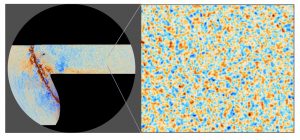Astronomers snap clearest ’baby picture’ yet of the universe
March 21, 2025 by A&S News (Abbreviated by Lyuba Encheva)
New research from the Atacama Cosmology Telescope (ACT) collaboration has produced the clearest images yet of the universe’s infancy from the earliest cosmic time accessible to humans.
Measuring light that has travelled for almost 14 billion years to reach a telescope high in the Chilean Andes, the two new images reveal the universe when it was about 380,000 years old — the equivalent of hours-old baby pictures of a middle-aged adult.
The international collaboration includes University of Toronto astrophysicists Richard Bond from the Canadian Institute for Theoretical Astrophysics (CITA); Adam Hincks, from the David A. Dunlap Department of Astronomy & Astrophysics (DADDAA); and Renée Hložek from the Dunlap Institute for Astronomy & Astrophysics.
The new pictures of the CMB are at a higher resolution than those produced more than a decade ago by the Planck mission, a space-based telescope designed to observe the CMB. ACT measures the intensity and polarization of the light at five times the resolution of Planck, and with around three times lower noise. This means the faint polarization signal is now directly visible in ACT’s images.
“There have been many results over the years but this is the most impressive in terms of data volume and the area of the sky covered,” says Richard Bond, a University Professor with the Faculty of Arts & Science’s Canadian Institute for Theoretical Astrophysics (CITA) and an ACT collaboration member. “Toronto played a big role in both the Planck mission to study the CMB and in ACT,” says Bond. “And it is that one-two punch that determined with incredible precision the standard model of cosmology. It is quite amazing.”
The new results confirm a simple model of the universe and have ruled out most competing alternatives, said the research team. The work has yet to go through peer review, but the researchers have submitted a suite of papers to the Journal of Cosmology and Astroparticle Physics and the results were presented at the American Physical Society annual meeting on March 19.
The U of T team also includes postdoctoral fellow Yilun Guan is a postdoctoral fellow at the Dunlap Institute for Astronomy & Astrophysics, a Schmidt AI Science Fellow, and a co-lead author of the latest research. Guan spearheaded two mission-critical components of ACT analysis: data selection and calibration. “These efforts were essential in producing this result, the most sensitive CMB map to date, covering over 40 per cent of the sky at high resolution — a milestone in modern observational cosmology,” he says.

Analysis of this Image of the CMB showing a patch of sky about 20 times the width of the moon. The orange shows regions of gar at a higher density; blue, less dense.
Credit: ACT Collaboration; ESA/Plank Collaboration.
Longtime members of the collaboration and co-authors include: Hincks, Bond and Renée Hložek, an associate professor with the Department of Astronomy & Astrophysics and the Dunlap Institute for Astronomy & Astrophysics.
“I’ve been involved in ACT since starting my DPhil in 2008 and these results represent the cumulative work of so many people over those many years,” says Hložek. “Also, it’s a real privilege to see my student Simran leading parts of the analysis of one of the papers and generating the ‘final ACT’ version of a plot I made for ACT in 2012.”
“The new, higher resolution image tells us the velocity of the gas and thereby reveals its dynamics,” says Hincks. “We get this map of the movement of the gas by measuring the polarization of the cosmic microwave background (CMB). We have done this to unprecedented sensitivity, giving a much clearer picture of the speed of the gas than was previously available.” It also gives the collaboration confidence that astrophysicists understand the behaviour of the early universe because it allows for another way of measuring how much atomic matter there is in the universe, how much dark matter there is, and how fast the universe is expanding. It significantly strengthens researchers’ confidence that they understand the theory behind what’s being observed.
Other Canadian contributors include researchers from the University of British Columbia and McGill University. In addition, Toronto has long played a key role by providing computing resources for ACT on the Niagara supercomputer of the SciNet High Performance Computing Consortium at the University of Toronto, both to local ACT members and to members in their international collaboration.
ACT’s new measurements have also refined estimates for the age of the universe and how fast it is growing today. The infall of matter in the early universe sent out sound waves through space, like ripples spreading out in circles on a pond.
A younger universe would have had to expand more quickly to reach its current size, and the images we measure would appear to be reaching us from closer by. The apparent extent of ripples in the images would be larger in that case, in the same way that a ruler held closer to your face appears larger than one held at arm’s length.
The new data confirm that the age of the universe is 13.8 billion years, with an uncertainty of only 0.1 per cent.
The pre-peer review articles highlighted in this release are available on Princeton University’s Atacama Cosmology Telescope website and will appear on the open-access arXiv website. You can read the full Princeton press release on their website.
Read the full Princeton press release on their website
In the News:
- A universal picture: Three discoveries shed new light on what happened after the Big Bang
The Globe and Mail | March 20, 2025 -
Canadian-built telescope captures the earliest light emitted by the Big Bang
Postmedia | March 20, 2025